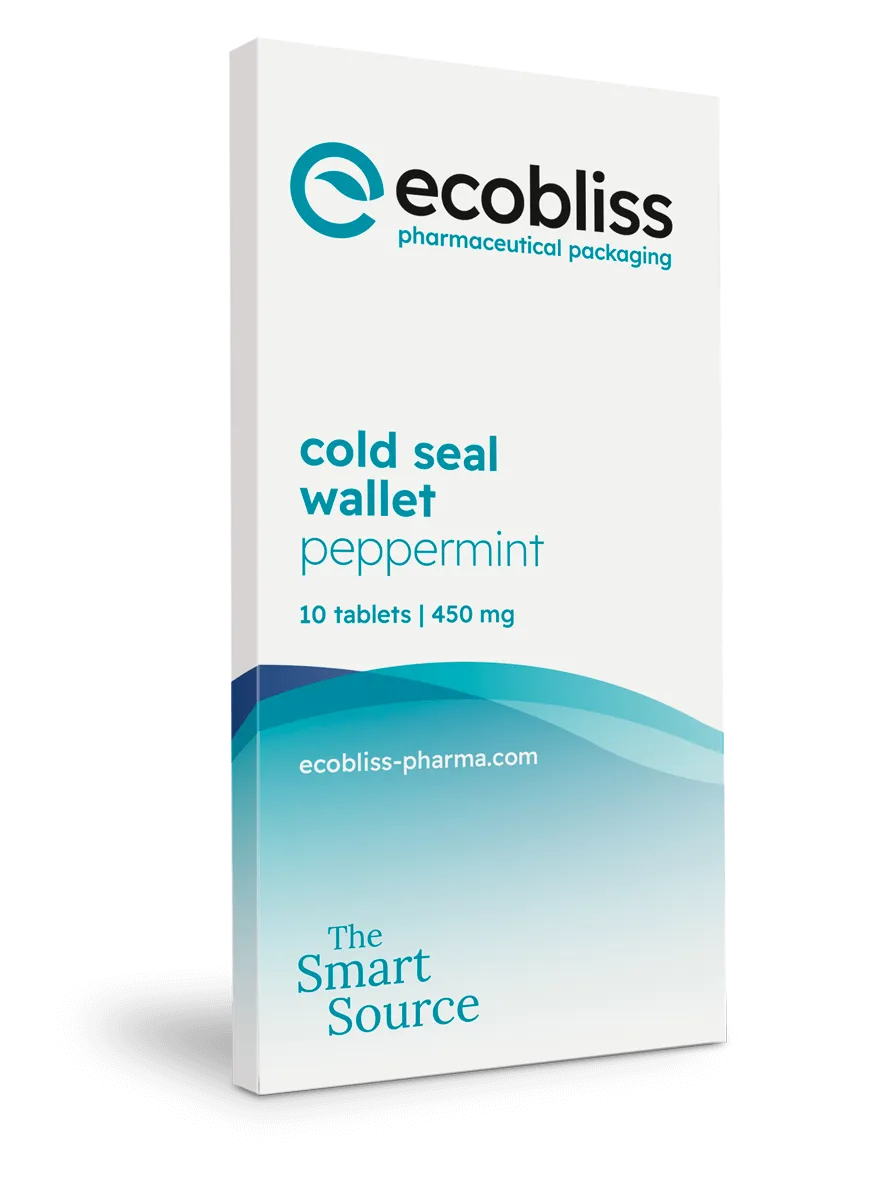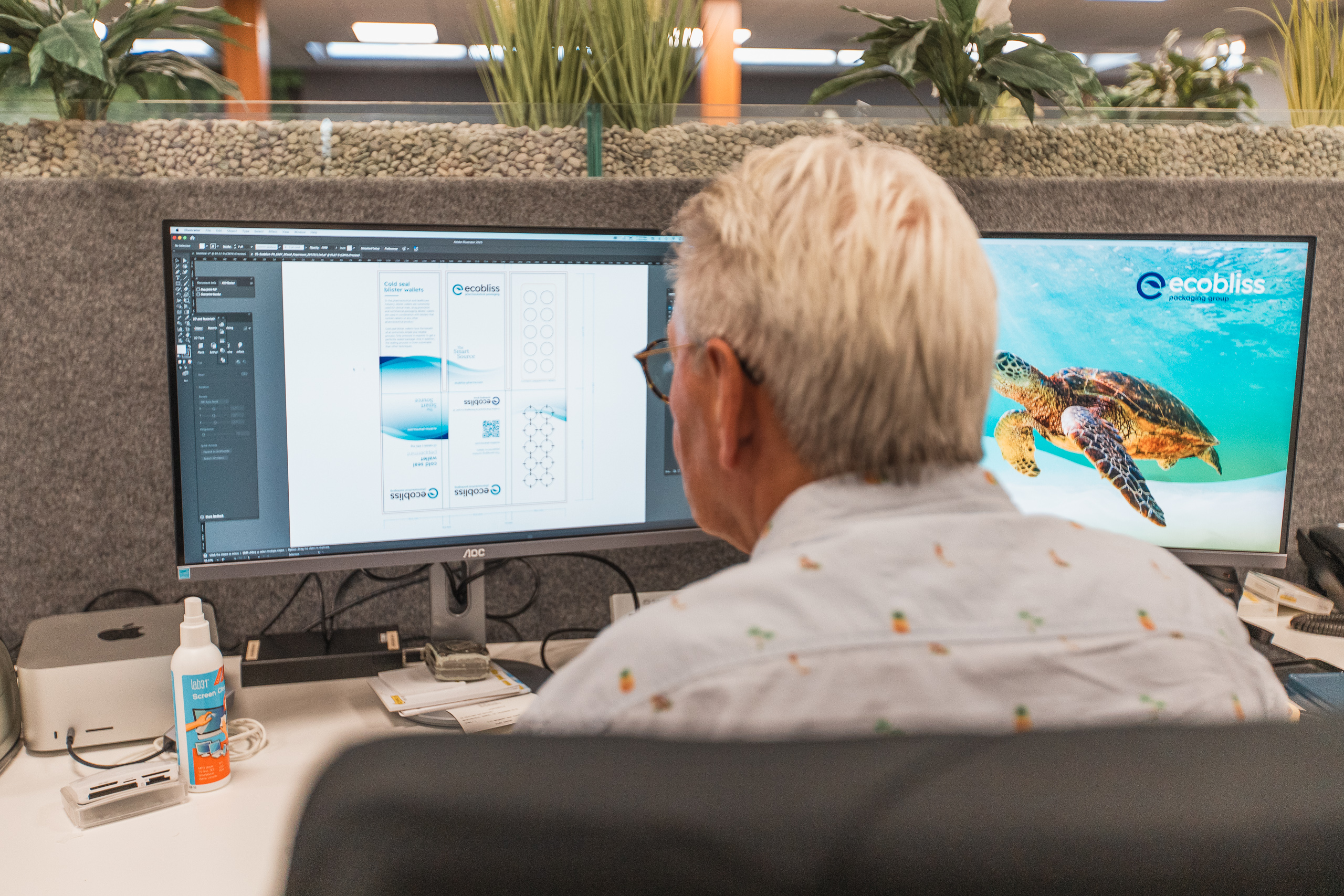Medicine packaging is usually not reused after opening because of safety, quality, and legal reasons. In pharma, the main priority is to avoid contamination and protect the medicine. Primary packaging, which touches the drug, must always stay sterile and secure. For this reason, reuse is not possible in most cases. Instead, teams can improve sustainability through recyclable materials, efficient pack design, and safe in-use options.
• Most medicine packaging, especially anything touching the drug, must only be used once.
• Reuse is blocked by safety rules, sterility concerns, and regulatory controls.
• Secondary packaging offers safer ways to reduce waste and improve recyclability.
• Cold seal wallets and right-sized packs help lower material use and support ESG goals.
• The best results come from smart design, not reuse of returned or opened packs.
What reuse means in pharmaceutical packaging
In consumer packaging, reuse often means refilling a container or taking it back to the store. In pharmaceuticals, the meaning is stricter. Medicine packaging has two parts. Primary packaging touches the medicine, like blisters, vials, or syringes. Secondary packaging holds these items and adds safety, labeling, and instructions. This may include wallets, boxes, or cartons.
Primary packaging cannot be reused once it is opened, because it may lose sterility or change the stability of the drug. In some specific cases, secondary packaging reuse may be considered, but only if the materials stay undamaged and are traceable. Understanding this split helps teams protect patients and reduce waste using realistic methods.
Why reuse in medicine packaging is not possible after the pack is opened
After opening, medicine packaging is exposed to possible contamination. It may no longer protect the drug properly. Teams cannot confirm if the drug stayed stable. Returned or opened packs are usually destroyed following standard safety rules. This helps avoid mix-ups, counterfeits, or incorrect dosing.
Modern packaging includes safety features like seals, holograms, or tracking codes. These are part of traceability rules such as the Falsified Medicines Directive. Once broken, those protections no longer work. Because of this, reuse programs are not accepted in normal pharma settings at home or in retail.
Where reuse happens and where it does not in logistics
Some packaging-related materials in pharma are reused, but these are upstream in logistics. Reusable crates, pallets, or insulated boxes often carry medicine between facilities. They are cleaned and used again in secure systems, and they never touch the drug itself.
These items are different from the packaging a patient receives. Patient-facing packaging must follow strict laws and usually cannot be reused. This is unlike sectors such as food or cosmetics, where reuse models are more accepted and pose lower risks.
Ways to reduce waste without reuse
Pharma companies reduce waste by cutting extra materials. This includes removing trays, plastic shields, or tamper bands when not required. Another method is downsizing. Smaller packs use fewer resources and reduce CO2 from shipping because they take up less space. Fewer components also mean simpler production.
These reductions must be tested and validated, but when safe, they lower the environmental burden without needing to reuse packaging. In this way, good design and proper validation help meet both regulatory and sustainability goals.
Secondary packaging that supports recycling
Secondary packaging gives more freedom for recycling. Materials like paperboard and mono-material wallets are easier to sort and recycle. By avoiding mixes of plastic and foil, packs become better for recycling plants. This helps reduce waste at the end of the product’s life.
Some of our solutions use cold seal blister packaging with recyclable layers. These designs are matched to paperboard and support both product safety and environmental goals.
Cold seal options for heat-free packaging
Cold seal technology uses pressure-sensitive adhesives to close packaging. It works without heat, making it useful for drugs that are sensitive to temperature. It also saves energy and makes the sealing process faster and more controlled. This helps reduce the footprint of small-batch or clinical trial production.
The cold seal method allows the use of flat, simple boards without inner laminates. This improves recyclability and supports lean design. It is one step toward sustainable medicine packaging that avoids the risks linked with reuse.
Smart packs that are reclosable, but not reused
Reclosable packaging can help patients take medicine correctly. These formats are often child-resistant, so they stay safe between doses. They also help avoid losing pills, cutting down on waste from early disposal. However, such packs are not suitable for return or refill. Once the drug is finished, the pack is discarded.
These designs are especially useful for home care and long treatments. Supporting correct storage and use helps patients follow their schedule and avoid skipping or doubling doses. This protects both health and environmental targets.
How smarter design reduces reuse needs
When a pack supports correct dosing, fewer medicines are wasted. Titration packs guide patients through step-by-step use, including dosage changes. This improves adherence and lowers the risk that extra medicine is left unused or handled improperly.
We created a 10-syringe packaging case that used a smaller, more effective wallet. It handled labeling, tracking, and use steps while lowering weight and bulk. This shows that better design can meet safety needs, reduce waste, and avoid the risks of reuse.
Better packs for clinical trials
Clinical trials often run in small volumes, which makes them a good place to test compact packaging. Trial kits must show clear instructions and protect the drug. At the same time, they should not waste materials.
We have built trial kits using flat boards and small inserts. These kits reduce material use without affecting function. All components are verified through GMP processes and meet pharma-grade standards, even when the design is lightweight or newly introduced.
Look at the full packaging life cycle
It is important to think about the full life cycle of a pack, not only what happens after use. Light packs reduce transport fuel use. Flat shapes take less energy to produce. Some materials have a smaller environmental impact from the start.
For more context, see how we approach sustainability in pharmaceutical value chains. Thinking about energy, waste, and materials across the full life helps avoid unintended risks and supports smarter planning.
Planning safe and validated changes
Before using a new format or material, teams must assess risks. This includes evaluating safety, child resistance, tamper protection, and print clarity. Format changes follow strict validation steps under GMP rules. In pharma, design updates are not taken lightly.
Reuse fails at many of these checkpoints. The benefits of reuse cannot outweigh the safety risks in most pharma settings. We focus on realistic, controlled steps that still deliver environmental gains. Our packaging changes follow documented review and full traceability standards.
What works and what does not in reuse of medicine packaging
Reuse of medicine packaging is not practical or permitted in most regulated pharma environments. Primary packs must be sterile, stable, and sealed. Once opened, they cannot be trusted to stay that way. Even for secondary packaging, reuse is rare and complex.
The best results today come from smarter packaging. Formats that are recyclable, light, easy to store, and clear to use have impact without risk. These support both patient needs and environmental goals. Learn more about our sustainability principles in regulated packaging.
Start with a quick check
If you're trying to cut waste safely, a quick scan of your current packaging can help. Our experts provide practical feedback based on years of verified use cases. We look at size, structure, sealing method, and recyclability.
Use our quick packaging scan to explore new options. It is a first step toward better sustainability in pharma, without needing reuse.
FAQ
Can medicine packaging be reused?
No, reuse of medicine packaging is not allowed in most pharma settings. Once opened, the packaging may lose sterility and cannot be trusted to protect the drug. Regulations require secure, single-use formats to keep patients safe.
What packaging parts can be recycled?
Secondary packaging such as cartons, boxes, and mono-material wallets is often recyclable. Primary packaging is more complex, and many parts like plastic blisters or coated foils are harder to recycle due to the materials used.
Are there regulations on pharmaceutical packaging reuse?
Yes, strict regulations prohibit reuse of any pack that has been opened or returned by a patient. These rules help prevent tampering, contamination, and errors. Regulatory documents like the Falsified Medicines Directive help enforce these standards.
What are safer alternatives to reuse in pharma?
Sustainable options include recyclable packs, compact formats, and cold-seal technology. These design choices improve environmental outcomes while staying compliant. Reclosable child-safe packs also reduce waste during use without encouraging actual reuse.
Request a free sample now!







.avif)

